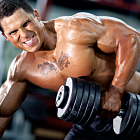 Q: I split my workouts between the gym and home, and for the home workouts I want to stick with practical exercises that require minimal equipment. What do you think about chinups supersetted with pushups for maintaining balanced muscles and ensuring good posture?
Q: I split my workouts between the gym and home, and for the home workouts I want to stick with practical exercises that require minimal equipment. What do you think about chinups supersetted with pushups for maintaining balanced muscles and ensuring good posture?
A: Well, not much—if you hope to develop and maintain structural balance. The idea of a push/pull superset is a good one, but for the purpose of structural balance you have to consider anatomy. The pushup is going to work your pectorals, which will pull the shoulders forward; the chinup is going to work the lats, and one of its primary functions is to internally rotate the upper-arm bones. The idea of the lats being internal rotators of the arms is lost among many trainers, but you only have to look at the posture of swimmers and gymnasts to see that the heavy emphasis on lat work among those groups often results in round shoulders.
With many so-called boot camp workouts, the problem is even worse because besides pushups and chinups they often contain a lot of situp-type exercises, involving spinal flexion, and front-delt work, such as vertical throws with medicine balls and military presses. Even if you throw in a few sets of power snatches to work the muscles that externally rotate the shoulders, it’s often not enough to compensate for the rest of the workout. The result is that muscles such as the infraspinatus and teres minor are placed under continual tension, a condition that makes trainees more susceptible to shoulder impingement and even shoulder dislocation. (I should mention here that Human Kinetics recently published Postural Assessment by Jane Johnson, M.Sc., which is a great book for coaches and personal trainers who want to learn how to assess posture.)
Rather than chinups, to help prevent round shoulders, I recommend you add rowing exercises to your program. In fact, as a general rule I would say that for every set of chinups you should also perform one set of rows. One of the best exercises for helping to correct the structural-balance issues resulting from too much bench pressing is the face pull. It works the rhomboids and middle trapezius, which help pull the shoulder blades together, and also the infraspinatus and teres minor.
Although you probably have a barbell set at home, I don’t generally recommend doing bent-over barbell rows from a standing position. With that exercise you expend too much neural drive in firing the erector spinae, glutes and hamstrings in your efforts to maintain good posture. As such, the lats and other upper-body pulling muscles don’t get much of a training effect. That’s not just my opinion—a study that appeared in the March 2009 Journal of Strength and Conditioning Research came to the same conclusion.
My favorite rowing exercises are one-arm dumbbell rows performed with thick-handled dumbbells. You can brace your upper body with your other arm on a bench, thus allowing you to devote more effort to working the upper-body muscles. Also, using a dumbbell enables you to row through a greater range of motion than a barbell allows, as you can use a neutral grip so that your chest doesn’t get in the way.
For your home gym I recommend you purchase an adjustable dumbbell set, preferably one with thick handles—that will take care of your forearm work. When you make it to a gym, consider trying one-arm cable rows, keeping one knee slightly bent so you can brace your hand against it.
The bottom line is that to develop all the upper-back muscles and promote structural balance, you should be sure to include a selection of rows in your training.
Editor’s note: Charles Poliquin is recognized as one of the world’s most suc-cessful strength coaches, having coached Olympic medalists in 12 different sports, including the U.S. women’s track-and-field team for the 2000 Olympics. He’s spent years researching European journals (he’s fluent in English, French and German) and speaking with other coaches and scientists in his quest to optimize training methods. For more on his books, seminars and methods, visit www.CharlesPoliquin.com. IM




















You must be logged in to post a comment Login